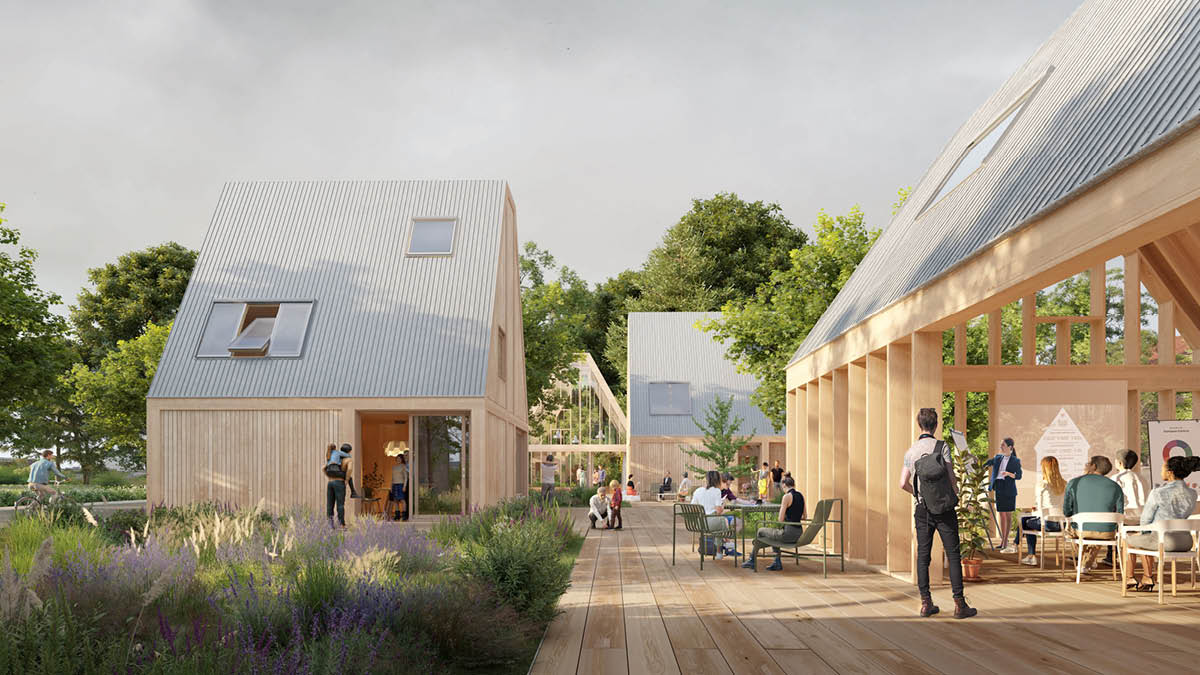
Nearly 38% of UK adults now split their working week between their offices and homes. But many of us live and work in buildings that lack sufficient ventilation and light, aren’t designed to stay cool in our increasingly hot climate, and use environmentally unfriendly materials. So, how can we build spaces that are healthy for people and the planet?
Transition to sustainable materials
Buildings and the construction industry have a carbon dioxide problem. Figures from the World Green Building Council show that together, they’re responsible for 39% of annual global CO2 emissions. Energy used to heat, cool and light buildings accounts for 28% of emissions, while the remaining 11% is the result of carbon emissions from materials and construction processes throughout the whole building lifecycle. To reach ambitious global climate goals, existing and future buildings must be redesigned to become more energy efficient, and we must transition to sustainable alternatives to concrete, steel, and aluminium – or find ways to lower the carbon footprint of these materials.
Improve ventilation to stop viruses from spreading
Despite our enhanced understanding of how airborne viruses spread, there is still currently no set of standards for mitigating the levels of bacteria or viruses indoors. Lone Feifer, director of sustainable buildings at roof windows company VELUX, says that mandatory ventilation standards must be enforced to stop the spread of respiratory illnesses indoors and the loss of workers through ill health. She adds: “Joseph Allen, the director of healthy buildings at Harvard University, firmly believes your building operator is more important to your health than your GP; at VELUX we are striving to challenge traditional thinking and to bring awareness to how our buildings can be healthy for both people and the planet, encouraging better daylight and fresh air in indoor climates.”
Use technology to create a healthy indoor climate
Buildings of the future must be thought of as a system of interconnected parts that work together to optimise energy efficiency and the indoor climate. “You need to be able to have flexibility to contain heat in winter, but in summer, you need shades or shutters that prevent the heat from coming in,” says Feifer. Since 2017, VELUX has used an integrated digital system to ensure its roof windows, blinds and shutters work in perfect harmony to do exactly that. Sensor-based ventilation tracks temperature, humidity and CO2 levels, and ventilates to keep the indoor climate healthy. Automatic heat protection protects homes from excessive heat by automatically closing blinds, awnings and shutters on hot days.
Use light and cooling for better night conditions
Humans have a circadian rhythm, or a natural sleep-wake cycle, that is regulated by exposure to natural light throughout the day. But many people live and work in buildings that don’t give enough access to daylight, which can disrupt our sleep patterns and affect our health. Designers should be mindful of this and ensure that buildings are designed to optimise exposure to natural light. Meanwhile, most European buildings don’t provide sufficient ventilation to cool them down at night. The heat generated during the day builds up and is absorbed into the building’s surfaces and structure. Night cooling uses natural ventilation to allow warm air to be exhausted and the building mass to be cooled. This process reduces energy costs and improves the energy efficiency of buildings.
Build partnerships to create sustainable cities
Change needs to happen at scale, but the building industry is a fragmented system of many different parts, including investors, contractors, engineers, architects and other specialist experts. As part of its Build for Life initiative, VELUX wants to build partnerships with each of these sectors to show them how to build sustainably using insights gathered through the company’s 80 years of experience. The end goal is to create liveable spaces that are healthy for people and the planet.
To bring this to life, VELUX will unveil its Living Places project in Copenhagen in 2023 – in partnership with Effekt architects, Moe engineers and Enemærke & Petersen contractors. Living Places will showcase healthy homes with a significantly lowered carbon footprint. This new way of thinking proposes healthy and sustainable housing that is affordable for many, due to the optimised choice of materials and easy assembly process. It encourages a more responsible, regenerative and collaborative approach.
Think about buildings in a new way, visit livingplaces.velux.com
Promoted by Velux

Nearly 38% of UK adults now split their working week between their offices and homes. But many of us live and work in buildings that lack sufficient ventilation and light, aren’t designed to stay cool in our increasingly hot climate, and use environmentally unfriendly materials. So, how can we build spaces that are healthy for people and the planet?
Transition to sustainable materials
Buildings and the construction industry have a carbon dioxide problem. Figures from the World Green Building Council show that together, they’re responsible for 39% of annual global CO2 emissions. Energy used to heat, cool and light buildings accounts for 28% of emissions, while the remaining 11% is the result of carbon emissions from materials and construction processes throughout the whole building lifecycle. To reach ambitious global climate goals, existing and future buildings must be redesigned to become more energy efficient, and we must transition to sustainable alternatives to concrete, steel, and aluminium – or find ways to lower the carbon footprint of these materials.

